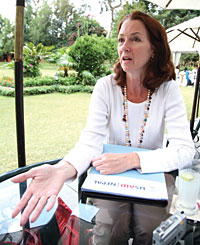 MIN RATNA BAJRACHARYA |
Nepali Times: The US has been providing development assistance to Nepal for over 50 years now. What are some of the lessons learnt?
The US was the first country to sign a technical cooperative agreement with Nepal in 1951 and since then we have achieved remarkable development outcomes with our partners. But certainly there's a lot more to be done.
In terms of lessons learnt, the first thing that comes to my mind is that we need local participation. In the past, "experts" would design programs without a lot of consultation with communities and other stakeholders. But we have recognised over time that community participation, buy-in, and support are absolutely essential for success.
The same is true regarding government commitment, without which the desired impact will not be possible. Donors can do the groundwork and initiate activities, but at the end of the day, government commitment is an absolute prerequisite for widespread, sustainable, positive changes.
We are trying to influence and accelerate development and economic growth, and there is often no specific tested method or blueprint for doing this in a particular country. Therefore, I believe there is a need for evidence-based approaches to development: researching the best practices in the region or in countries with similar issues, bringing them to Nepal as pilot projects, gathering relevant data to evaluate their impact and then rolling out and scaling up those programs. We also need to be thinking of sustainability and an exit strategy right from the very beginning in order to ensure that development results are fully sustainable and effective.
We've also discovered that money is not the answer to everything. What is most important for development is commitment at the community, district and national level. We have seen great impacts with only small investments?like the community forest users group. Those minimal investments when combined with people's dreams and aspirations go a long way. When people see that they have the power to change their lives positively, the development possibilities are boundless.
But the criticism is that despite the millions of dollars spent, there hasn't been much poverty reduction.
Well, I'm not sure if I agree with the basic premise of this question. Since 1951, the US has provided over a billion dollar worth assistance to the people of Nepal. Results speak for themselves. Look at the socio-economic indicators.
During the early 1950s, the population stood at 8.5 million. Today it is 29 million. Life expectancy was 28 years compared to 63 years today. The literacy rate was 5.3 per cent back then. It is now at 79 per cent for men and 55 per cent for women. The same is true with college enrollment: 300 college students versus 132,777 enrollments today. There were 376KM roads during the 1950s compared with 17,280KM today.
There are actually a lot of indicators we can use to show development progress. Poverty rates have also improved, but maybe not as significantly as other development trends in Nepal.
The only possible reason I can think of why this impression exists is because development is a slow, gradual process. Development doesn't happen overnight. I personally believe Nepal has made some very good progress in the last 50 years. So one might ask why hasn't there been more rapid progress. Granted, we have a lot more to do to support marginalised, disadvantaged, conflict-affected populations, but in general there have been great results.
I lived in Nepal for almost eight years during the 1970s. I went to school here and my experience shaped my interest in development. I came back as the Director of USAID in 2007 after 30 years away, and have personally witnessed dramatic improvements in forestry, poverty, public health and infrastructure.
What is USAID's prime focus now?
US foreign assistance programs promote peace and stability by fostering economic growth, protecting the health of Nepali families, providing emergency humanitarian assistance and nurturing democracy.
These will remain our focus areas. But in all of these, we have a special focus on supporting Nepal's youth. USAID has immense faith in the youth of Nepal and it is one of our highest priorities to engage with this group. We have been a firm supporter of various youth initiatives and programs that promote peace and reconciliation, provide skills training and create new job opportunities.
Does the emergence of a Maoist-led government change your operational methods in Nepal in any way?
USAID's programs are aimed at helping the Nepali people and we look forward to working with the government to help achieve development goals. Our relationship is with the government, not any particular political party.


